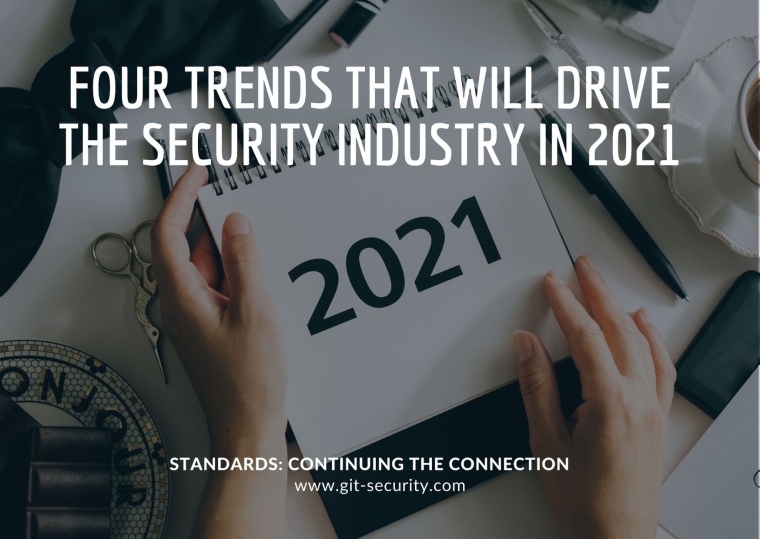Four Trends That Will Drive the Security Industry in 2021
Despite continued pandemic-related challenges, the security industry has seen a renewed focus on technologies used to mitigate risks associated with Covid-19. In 2021, this will likely continue, as industries across the globe shift the way they conduct business. Per Björkdahl, who is the current Chair of the Onvif Steering Committee, tells us about his expectations of the coming year.

Technologies such as occupancy management, automated visitor management and touchless access control applications are increasing in demand – turning up the dial on interoperability as organizations seek to deploy best-of-breed solutions. To power these technologies, artificial intelligence (AI), cloud storage and the Internet of Things (IoT) are driving new functionalities and new uses from existing technologies to deliver customized applications for pandemic-related health, safety and security issues. While this year might bring a number of uncertainties, we remain confident that the industry will continue to see growth and demand for these trends.
AI and IoT Gain Mainstream Attention
It comes as no surprise that the biggest security trends we anticipate seeing in 2021 will be a continuation from last year – IoT and AI. As IoT and AI blend together, each is needed to become more efficient in general. IoT has laid the foundation for AI and video analytics to be very impactful in 2021. As IoT-connected devices rise and the demand for integrations of smart applications accelerates, these technologies – once novel to the security industry – are becoming more mainstream. This increased focus is leading to more investment in analytics, as organizations search for solutions to adapt to the new way of life, while reopening economies and rebooting infrastructure.
Video Analytics to Mitigate Covid-19 Threats
This past year, we saw the pandemic act as a catalyst, spurring innovation and creating new technologies as well as offering new uses for existing technologies. Video analytics were one such technology, as many of the touchless and thermographic solutions used to help mitigate health risks and reopen businesses would not be possible without video surveillance.
For example, the use of video analytics to determine occupancy levels in commercial buildings and detect social distancing are soon to assist smart cities. While this doesn’t necessarily mean public skepticism towards video surveillance has decreased, it has enabled the industry to show the breadth and depth of possibilities within the video analytics field outside of more commonly-known technologies, such as facial recognition. The disruption caused by Covid-19 has opened up opportunities for video surveillance to prove its value beyond simple video recording, providing organizations across the board with valuable business intelligence for pandemic uses and beyond. At the end of the day, it has highlighted additional use cases and opened up the conversation about adoption of such technologies and new markets where they may be applied.
The Cloud’s Value Continues to be Realized
In early 2020, we spoke about how the security industry was truly embracing the cloud, specifically in the IoT space, as worldwide spending on cloud services and infrastructure was steadily increasing. As we enter 2021, we feel confident that this trend will continue to increase, as pandemic (and post pandemic) requirements offer myriad opportunities in the cloud space. While the cloud is by no means new to security, the growth in video surveillance in the cloud is now being propelled by both security and non-security uses.
Offering cost-effective price points, cloud solutions provide ongoing flexibility and a variety of opportunities for organizations of all sizes – meeting operational needs that are heightened or accelerated by the Covid-19 pandemic. Many businesses are re-evaluating traditional usage of their existing technologies or seeking other methods to assist with day-to-day operations. The cloud can assist businesses with the remote monitoring of vacant spaces or provide additional coverage where less staff onsite are required. For small to mid-sized organizations, this remote monitoring can be useful beyond pandemic uses, as it allows for the revoking of access rights, creation of schedules and access control monitoring from a remote location.
Interoperability of Systems Crucial in a Post-Pandemic World
In the light of the increasing number of connected devices and new opportunities in video analytics for pandemic-related uses and beyond, the demand for interoperable systems has only increased. Covid-19 highlighted this need for interoperability, as end users seek to integrate many of the technologies required to continue business as usual. Such technologies include video analytics to assist with occupancy management, the enforcement of social distancing and compliance with facial covering requirements.
For interoperability of IP cameras, or analytics applications with video management systems, Onvif’s Release Candidate for Profile M will be a valuable contribution and component for organizations seeking flexible, cost-effective solutions for their smart applications. The Profile M Release Candidate aims to standardize the communication of metadata and event handling of analytics for smart applications. It would allow users to more easily mix and match analytics and camera hardware and software from different providers. And it would provide the possibility of an integration path into IoT systems, with a way to link devices, such as IP cameras, into building management or other business intelligence platforms.
Greater Choice
To meet the rising demand for smart applications driven by security, business intelligence and IoT devices, clients and devices conformant with Profile M would encourage further growth in the number and types of applications, resulting in even greater choice for end users. Interoperability and the possibilities with Profile M could bring market potential for smaller, innovative companies in the analytics space and freedom of choice for end-users.
The continuation of these trends in 2021 – cloud technology, IoT, AI and expanding uses for video analytics – will garner even more attention than previous years. This is due to the fact that they all blend together, each becoming more efficient with the assistance of the other. Cloud technology is becoming more and more vital and can boost the performance of IoT. Conversely, AI can also benefit from IoT to work more efficiently. Much of this has enabled cloud technology and the rise of IoT to lay the foundation for AI and video analytics. It certainly will be an interesting year, as the security industry and beyond continue to build back from a present and post-pandemic environment.












